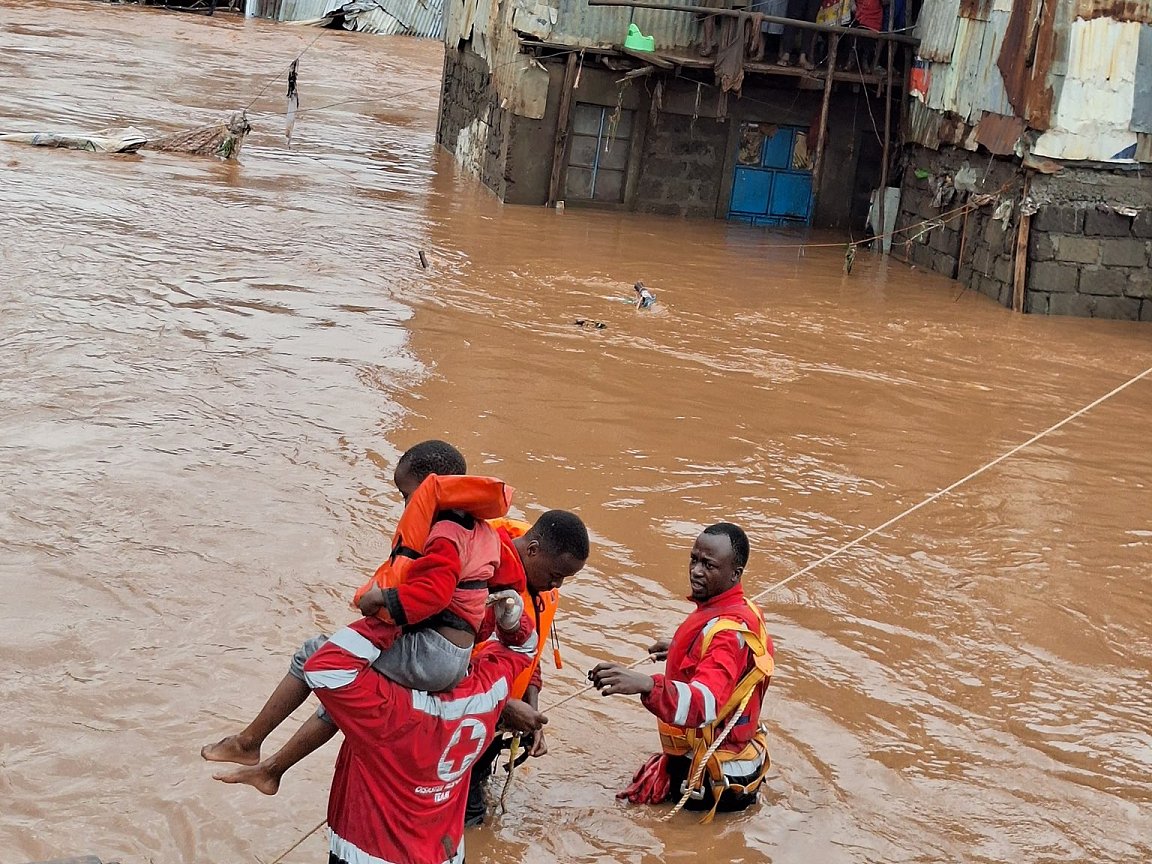
East Africa floods: ‘This is the worst I’ve ever come across in my career’

By the Climate Centre
The Secretary General of the Kenya Red Cross, Ahmed Idris, has said Kenya, Tanzania and other African countries are “bearing the brunt” of climate-related extreme-weather events like the very intense rain that has been causing lethal floods in recent weeks.
Speaking to Sky News yesterday, he said heavy rain at this time of year – the local long-rains season – was not an isolated incident in itself, but recently “the intensity [of the rains] over a short period of time is causing the massive flooding.”
Mr Idris added that after 20 years of climate change, “We anticipate that the wet seasons will be getting wetter and the dry seasons and hot seasons getting hotter.”
As of Sunday, more than 19,000 Kenyan households have been displaced, with Tana River the worst affected county, the KRC said in its latest update; the National Society had rescued 450 people, distributed nearly 3,000 emergency-shelter kits, and shared 35 million early-warning text messages, among many other interventions.
Tana River resident Hawa Ibrahim told a KRC camera crew that she and her children had fled the rising waters with just what they could carry after four days of intense rainfall; her village was inundated on the fifth day. They were now sheltering in one of more than 50 makeshift camps in the county, but without basic facilities or a safe water supply.
In one of the most lethal incidents, scores of people are reported to have died near Mai Mahiu town 60km from Nairobi when a culvert under a railway line became blocked by debris leading to a flash flood.
‘The floods of 2023 and 2024 exacerbate the humanitarian crisis as parts of Kenya emerge from the worst drought in four decades’
KRC Emergency Response Manager Anthony Muchiri told the BBC that the death toll there had risen to 50: “This is the worst I’ve ever come across in my career,” he said, adding that even the foundations of people’s houses in the villages were swept away in the sudden torrent after water spilled over the track.
In a report today, the KRC said 76 people are now reported missing by its tracing desk while 110 had been rescued.
The ICRC Nairobi regional delegation sent its “deepest condolences to the people of Mai Mahiu and everyone enduring the devastating impact of the floods”.
Other people attempting to move around during flash floods in south-east Kenya especially escaped after only very dramatic rescues by emergency services.
IFRC Secretary General Jagan Chapagain said on X/Twitter on Sunday that the situation in Kenya demanded “immediate humanitarian assistance”.
Since November, a combination first of heavy rain related to El Niño and then seasonal rains intensified by the warmer atmosphere had “triggered devastating floods and river overflows, causing more than 100 deaths and widespread damage.”
Climate Centre science lead Liz Stephens said today: “Climate scientists have warned for many years about the projected increase in this kind of heavy rainfall.
“The international community and donors needs to come together to make sure countries such as Kenya, Tanzania and Burundi – facing the latest episode – have the resources they need to support the comprehensive management of flood-risk needed to be resilient to these growing dangers.”
The IFRC’s emergency appeal for Kenya flood response, launched in late November and supported by an initial IFRC-DREF grant of 750,000 Swiss francs, seeks 18 million CHF but is currently only 16 per cent covered.
Opposite extremes
The KRC first activated its early action protocol for floods earlier in the month, as did the Uganda Red Cross Society.
Heavy rains were also affecting (alphabetically) Ethiopia, Somalia, South Sudan, Tanzania and Uganda, “necessitating a major humanitarian response”, the IFRC said at the time.
Broadly speaking, different African National Societies have been facing both opposite extremes aggravated by El Niño and alternating extremes in the same place.
“The floods of 2023 and these 2024 floods are exacerbating the humanitarian crisis as parts of [Kenya] have just emerged from the worst drought in four decades, which has left millions of people hungry,” last week’s operational update from the IFRC in Nairobi said.
“Lack of income, high commodity prices, and depleted livelihoods caused by five consecutive dry-seasons is expected to continue driving food insecurity in these regions.
“The drought coupled with these rains underscores the climate change challenges that Kenya and other countries in the Horn of Africa are grappling with.”
Eighteen people – 11 adults and seven children, the boy in the photo among them – were rescued last Wednesday by a Kenya Red Cross response team in the Mathare district of Nairobi after being cut off by floodwater. (Photo: KRCV via social media)